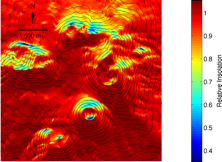2011 Annual Science Report
 University of Hawaii, Manoa
Reporting | SEP 2010 – AUG 2011
University of Hawaii, Manoa
Reporting | SEP 2010 – AUG 2011
Permafrost in Hawaii
Project Summary
We investigate microclimates on the Hawaiian Islands that serve as possible analogues to Mars. The summit of Mauna Kea is exceptionally dry, but sporadic permafrost exists in cinder cones near the summit. Additionally, ice caves are known to exist on the flanks of Mauna Loa. They are the world’s most isolated ice caves. Theoretical models have been developed for microclimatic effects in craters and caves. Preparations for upcoming fieldwork have been made and interdisciplinary collabora-tions have been developed.
Project Progress
The persistence of ice in terrestrial microclimates is investigated at several field locations, in craters near the summit of Mauna Kea, Hawaii, and in ice caves on Mauna Loa, Hawaii. Although the summit of Mauna Kea is exceptionally dry, sporadic permafrost exists in cinder cones near the summit. Additionally, ice caves can be found on the flanks of Mauna Loa.
Theoretical models of the thermal environment have been developed to better understand microclimatic effects and predict where on Mauna Kea permafrost may be found. This modeling includes threedimensional illumination calculations of direct and reflected sunlight, using azimuth rays and a computationally efficient method for multiple reflections, and the radiative effect of “cold air lakes”. Based on these model calculations, patches of regolith-covered permafrost are pre-dicted to exist in several heretofore unexplored craters. In the Mauna Loa ice caves, the crucial mi-croclimatic effect is the sinking of cold air into a lave tube with a single downward sloped-entrance.
Field work will begin in November. We will survey the ice caves and craters, emplace data log-gers, and assess the astrobiological potential of the field sites.

Annual mean insolation in the summit region of Mauna Kea (latitude 20°N), relative to a flat surface at the same latitude. Direct insolation (incoming solar radiation) varies by a factor of ~3 within a crater. Contours are elevation.
-
PROJECT INVESTIGATORS:
-
PROJECT MEMBERS:
Norbert Schorghofer
Project Investigator
Jocelyne DiRuggiero
Co-Investigator
Christopher McKay
Co-Investigator
Scott Rowland
Co-Investigator
Kenji Yoshikawa
Co-Investigator
Andreas Pflitsch
Collaborator
Stephen Smith
Collaborator
Alberto Robador
Postdoc
-
RELATED OBJECTIVES:
Objective 2.1
Mars exploration.
Objective 5.3
Biochemical adaptation to extreme environments
Objective 6.2
Adaptation and evolution of life beyond Earth